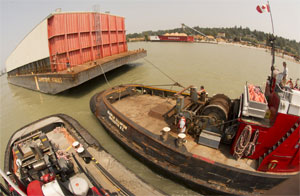“When Seaspan designed these boats, they involved their senior skippers,” explained Capt. Gordon Lazarowich. “They got boats that are perfectly suited to their work.”
Lazarowich was referring to his current command, Seaspan Tempest, and sister ship Seaspan Venture. The 65-by-25-foot hulls were built in China to a Seaspan design, before being shipped by barge to Canada for finishing in-house at Seaspan’s subsidiary Vancouver Shipyard. The hull design is elegant. It includes a double chine to ease lateral moves and a bow thruster to help the boat swing around a barge. The full belly sweeps up well ahead of the props for strong water flow. The designers put the stern at the height of a loaded barge and the bow at the height of an empty barge for the safety of crewmen who move from tug to barge.
In Canada, Seaspan installed a pair of Cummins KTA38 engines in each boat, giving them an operational 1,700 hp. The high-visibility wheelhouse is set on sound isolators above the main deck. Designed to work as day boats on the Fraser River, there are no bunks. A handy galley has been installed in the forecastle for hot-meal preparation.
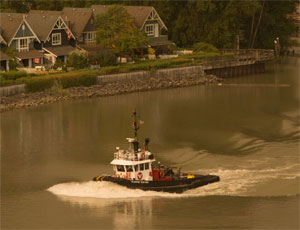 |
|
Seaspan Venture is a sister ship to Seaspan Tempest. All of the vessels work as day boats on British Columbia’s Fraser River. |
As day boats, a skipper and deck hand work 12-hour shifts for seven days and then enjoy seven days off. One day in July, Lazarowich and deck hand Chris Hemmingson were already two hours into their 0530 to 1730 shift when the Seaspan dispatch office called to give them their next job. They were about 35 miles up from the sea, but still within the tidal-effect zone. Barnston Island divides the river at this point, making the south branch — where Tempest was working — narrower than the main arm. The water access to lower-cost land on the edges of Greater Vancouver made this a good location for several sawmills. The job involved moving a loaded chip barge back from the loading spout, crossing the river to pick up an empty moor there and then dropping it into the newly vacated spot under the loading spout. Coming alongside the loaded barge at 0655, Lazarowich directed Hemmingson onto the barge. Once there, Hemmingson used his pike pole to lift the wire bridles from the stern of the tug and drop them over the bollards on the front of the barge. Lazarowich directed him to let the lines go so that he could use the tug’s power astern and the river current to ease the 212-by-53-foot barge downriver to moor it clear of the loading bay.
It was much-practiced teamwork. By 0705 Hemmingson was back on board and Tempest was crossing the river channel to pick up the empty barge. At 200 feet by 50 feet, this barge was a bit smaller and one of the company’s more conventional barges for which Tempest and Venture were designed. When empty, the height of the bow aligns with the height of the barge deck, making a safe and easy transfer of the deck hand over the bow of the tug. Once loaded, the deck level matches the stern level of the tug.
Once the bridles had been dropped over the empty’s bollards and the lines were let go, Lazarowich put the tug at 90 degrees to the barge bow and yarded it out into the river stream with his deck hand remaining on the barge. He needed only to run it a short distance downriver and spin it so that the bow was once again facing upriver. There was about 1.5 knots of river current.
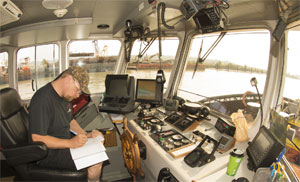 |
|
Capt. Gordon Lazarowich updates his logbook during a straight run on the river aboard Seaspan Tempest. |
“A nice amount of current,” Lazarowich said. “It is easier to work with current than without. In freshets we can get up to 6 knots of current, which is not the best as you are effectively landing a barge at 6 knots.”
Lazarowich moved from the wheelhouse controls back out to the controls on the aft deck and, with the bridles now shortened so that the tug and barge were one unit, he laid it alongside the mooring. Hemmingson picked up the mooring lines and was back aboard the tug within 10 minutes of boarding the barge. The aft controls afforded Lazarowich a clear view of the big Burrard Iron single-drum towing winch, the fantail and his deck hand. The controls included throttle and clutch, jog-style steering lever, bow thruster and winch.
Once again, operator involvement in the early design stages was made clear. The 1,700 hp, providing 48,000 pounds of bollard pull from the boat’s two Cummins KTA38 mains, provided the power to spin a barge in these currents. Unlike log-towing tugs with props angled to push their wash under a boom, Tempest has deep but less-angled props for optimal barge handling.
At 0716 the team picked up the larger-loaded barge and headed downriver. With the tug and barge on a straight course, Lazarowich handed off the traditional wood wheel to Hemmingson and used this straight run to update his logbook. Dispatch had directed them to take the loaded barge downriver to meet up with an “outside” tug for the tow up the coast to a pulp mill.
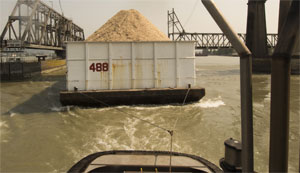 |
|
The Seaspan Tempest crew pilots a barge full of wood chips through the railroad swing bridge at New Westminster with room to spare. |
Lazarowich said his dad had captained log-barge towing tugs but he chose to go logging for a time before returning to deck work on tugs with a smaller company in 1987. By 1997 he had earned enough time, including some coastal towing, to qualify for his 350 unlimited tug master’s papers. He has been with Seaspan since 1998. He is proud of Seaspan Tempest and its exceptional handling abilities of which he, as operator, is an integral component.
About six miles downriver from the loading site, at 0800, the tug and barge passed under the new Port Mann highway bridge, making 10.3 knots on 3/4 throttle and the help of 4 knots of current — a combination of river flow and ebb tide. Less than 10 minutes later an order change came over the VHF from the dispatcher. There was another tug coming upriver that urgently needed a different loaded barge. This required Lazarowich to take the wheel and spin the barge 180 degrees to go upriver a short distance and pass around the top end of a small island to access the desired barge. Once again the two men did that mooring dance to tie up one barge, drop the bridles, put them up on the new barge, drop those moorings and get underway. At the same time Lazarowich and Hemmingson noted that one of the other moored barges seemed to be a couple inches lower to port. They reported this to dispatch so that they could have other tugs in the area keep an eye on it.
Moving upriver to round the top of the island, Lazarowich turned back downriver toward a cluster of three bridges at New Westminster. Two of the bridges, one for the sky train and the other for automobiles, are high-elevated suspension bridges, but the third is an ancient railway swing span that opens to provide two passages. The bridge has been hit in the past, causing significant damage and delay to both trains and marine transport. Lazarowich explained the basics of transiting the bridge when downbound: “You take the south (left-hand) hole due to the set of the tide and the swing span alignment. This leads to green-to-green passing of any vessels that might be headed upriver.”
Other boats have been lost in this stretch of the river when they get in irons. If the bridles are short and the boat is overtaken by its tow, this can cause the tug to be rolled over by the barge. “I keep the towline shackle centered over the stern fender instead of out to one side,” Lazarowich said. “If it is a big barge I have out a little extra line to allow me to flop back alongside the barge with the tug if anything goes wrong.”
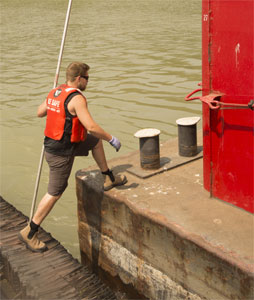 |
|
Deck hand Chris Hemmingson boards a barge from the stern fenders. |
Towing a gravel or chip barge through this bridge, whose rail line links Vancouver and Seattle, is routine for river captains — except in the big spring freshet. But towing a big 400-by-88-foot log barge with a 6,300-hp tug with 204,000 pounds of bollard pull is something else altogether. It is Seaspan policy to have one of the company’s senior river captains on the bridge for the passage when one of these big tows has to be brought up the river. Lazarowich has done this many times, but, as with the moving of chip barges, he is never casual. “If you want to make time,” he said, “do it on the straight stretches, not on a landing or maneuvering.” He added his take on situational awareness: “Be aware of your surroundings, from sandbars to recreational boaters.”
With the bridges passed and clear water ahead, Lazarowich and Hemmingson turned to planning the transfer of the loaded barge to the venerable 50-year-old coastal tug Seaspan Queen. They caught up with Queen just below the Alex Fraser highway bridge. That tug and one loaded barge were moored alongside a fleet of stored barges. The crew of Queen had pre-set soft line couplers on the stern of their first barge. Lazarowich swung his tow in behind the first barge and Hemmingson stepped across to the barge to take one bridle off so that Lazarowich could pull the barge up from off the starboard side with the single bridle wire. Hemmingson quickly made up the soft lines and Queen was ready to turn the close-coupled, double-barge tow up against the river current before heading off downriver. The two loaded barges were to be towed up Howe Sound to a paper mill at Port Mellon. The weather was calm so the short-coupled barge would be fine for that relatively short run. Queen and the tow were away at 1145.
Keeping in touch with their dispatcher, the crew of Tempest made time back upriver to retrieve the barge that they left behind. Another tug, Seaspan Champion, was already upbound in the river for a rendezvous to take the barge. Hemmingson took the wheel for the run upriver while Lazarowich caught up on his log. By 1215 Tempest had its bridles on the big chip barge that they had moored up above the New Westminster bridges. At 1325 the tow approached the coastal tug Seaspan Champion.
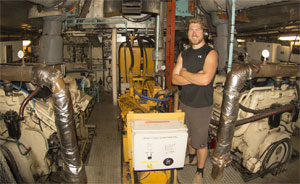 |
|
Hemmingson on watch inside Seaspan Tempest’s spacious engine room. The company equips its boats with a pair of Cummins KTA38 main engines. |
As with Seaspan Queen, this would be a tandem tow but crossing the more open waters of the Gulf of Georgia to a mill on Vancouver Island, so the barges could not be close-coupled with soft lines. Champion’s tow utilized what U.S. operators call the “Canadian link,” a shackle in the main towline to which a second set of barge bridles can be attached.
To start the process, Tempest, with its tow, came alongside the bigger Champion. Hemmingson, on the front of the barge, replaced one and then the other side of Tempest’s bridles with those of Champion. He then re-boarded Tempest and Lazarowich ran the boat up alongside a set of deep-sea ships moored on the river’s south shore to a barge loading facility. A 224-by-64-foot covered barge was moored, stern to the shore, in a tight slip. Using the same teamwork, the two had it following obediently behind Tempest in a matter of minutes. Running back downriver, with Hemmingson still on the covered barge, they met up with Champion and the original chip barges. Idling up against the river current, Champion paid out wire from its towing winch. With the chip barge several hundred feet astern, the Canadian link came off the winch drum and the crew shackled a set of bridles in place. Now Tempest laid its port side near Champion’s starboard side. Hemmingson traded Tempest’s port-side bridle wire for Champion’s port-side bridle and the barge swung into place behind the big tug. Next Hemmingson did the same with the starboard-side bridles. The main towline could be seen passing under the covered barge to the bridles of the chip barge tagging along behind but with enough separation that the two barges could encounter some weather without doing each other any harm.
After Lazarowich retrieved Hemmingson from the barge, Champion began a slow 180-degree turn to face downriver and to the sea. Lazarowich and Hemmingson were just over nine hours into their 12-hour shift. They had moved a lot of tonnage and dispatch sent them off to a cedar mill downriver to move another barge. Lazarowich talked with the pilot of a car carrier coming up the river. The pilot was the son of another well-known river family. They exchanged the kind of relaxed greetings that one expects from a community that has worked together over the generations and shows every sign of doing so for generations to come.

